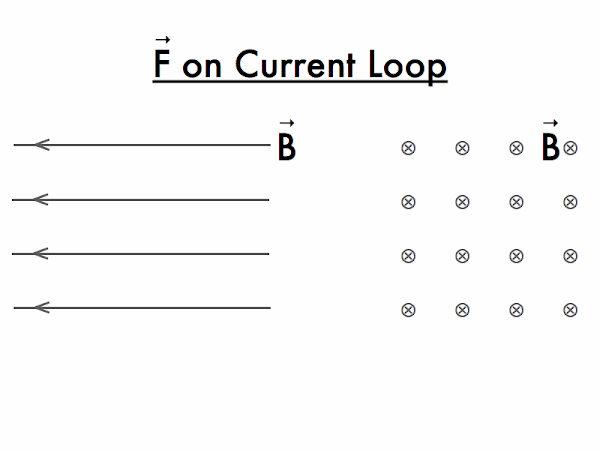
Look at those magnetic field lines. Just look at them.
F-exerting magnetic fields--how do they work? (Video link: "
Magnetic Movie.")

In a
previous presentation we looked at the magnetic fields of bar magnets, with both a north pole and a south pole. Here we will consider magnetic fields created by various configurations of current-carrying wires.
 Recall
Recall that instead of objects directly exerting magnetic forces on other objects, in the two-step model of magnetism, a source object creates a magnetic
B field everywhere around it, and it is this magnetic field that exerts a force on a test object.

First, magnetic fields exerting forces on test objects: current-carrying wires.

This is the second step of the two-step model of magnetism. A magnetic
B field will exert a magnetic forces on a test object such a straight section of current-carrying wire, or a closed loop of current. Here we will emphasize the
direction of the magnetic force on the test object, exerted by the magnetic
B field.

The direction of this magnetic forces is given by the
first right-hand rule (RHR1, or "Hidden Dragon"), where the thumb is used either for the velocity direction of a positive charge, or for the direction of "
conventional current" (positive charge flow) along a straight section of wire.
 Any
Any closed loop of current can be modeled as a square (or at the very least, quadrilateral), with four straight sections of current. In this example the loop is slightly askew with respect to a uniform (constant direction, constant magnitude) magnetic field. Convince yourself using RHR1 that two of the sections will have forces exerted on them by the magnetic field that will result in the loop turning until it is perpendicular to the magnetic field. (The other two sections also have forces exerted on them, but they will not contribute to turning the loop.)

Second, source objects that create magnetic fields: current-carrying wires.

On the left is the
second right-hand rule (RHR2, or "Crouching Tiger"), and the closely related third right-hand rule RHR3, both of which are used to determine the direction of the magnetic field created by current-carrying wires.

This is the first step of the two-step model of magnetism. A source object such a straight section of current-carrying wire, or a closed loop of current will created a magnetic
B field everywhere around itself. Here we will emphasize the
direction of the magnetic field created by the test object.

For a straight section of current-carrying wire, RHR2 is used, where the thumb points along the direction of (conventional) current
I along the wire, the top of the palm represents the distance
r from the wire to a specific location in space, and the direction of the magnetic
B field at that location is indicated by the direction of the "curl" of the tips of your fingers. Here for every point at the same distance
r from the wire, the magnetic
B vectors all point in the same direction around the current-carrying wire, such that the magnetic field
line (which must form a closed loop) circles around in the direction given by the curl of your right hand fingertips.

To demonstrate the circular magnetic field lines that surround a straight section of current-carrying wire (perpendicular to the plane of this page), here iron filings suspended in oil are initially aligned in random directions near a straight section of wire with no current, and then when the current is turned on, these iron filings will behave as tiny test magnets, aligning themselves parallel to the magnetic field at each of their locations. (Video link: "
PH EM MF DEMO 70001A V1025 2D Magnetic Field Demonstrations Simple Wire Coils.")

For a circular loop of current-carrying wire, RHR3 is used, where instead the direction of the tips of your fingers curl in the direction of the (conventional) current
I along the wire, and the thumb points in the direction of the magnetic
B field anywhere inside of the loop. Note that the magnetic field circles around, since magnetic field lines must form closed loops.

To demonstrate the magnetic field lines that surround a circular loop of current-carrying wire, again iron filings suspended in oil are initially aligned in random directions when there is no current in the loop, and then when the current is turned on, these iron filings will behave as tiny test magnets, aligning themselves parallel to the magnetic field at each of their locations. (Video link: "
PH EM MF DEMO 70001A V1025 2D Magnetic Field Demonstrations Simple Wire Coils.")




























No comments:
Post a Comment